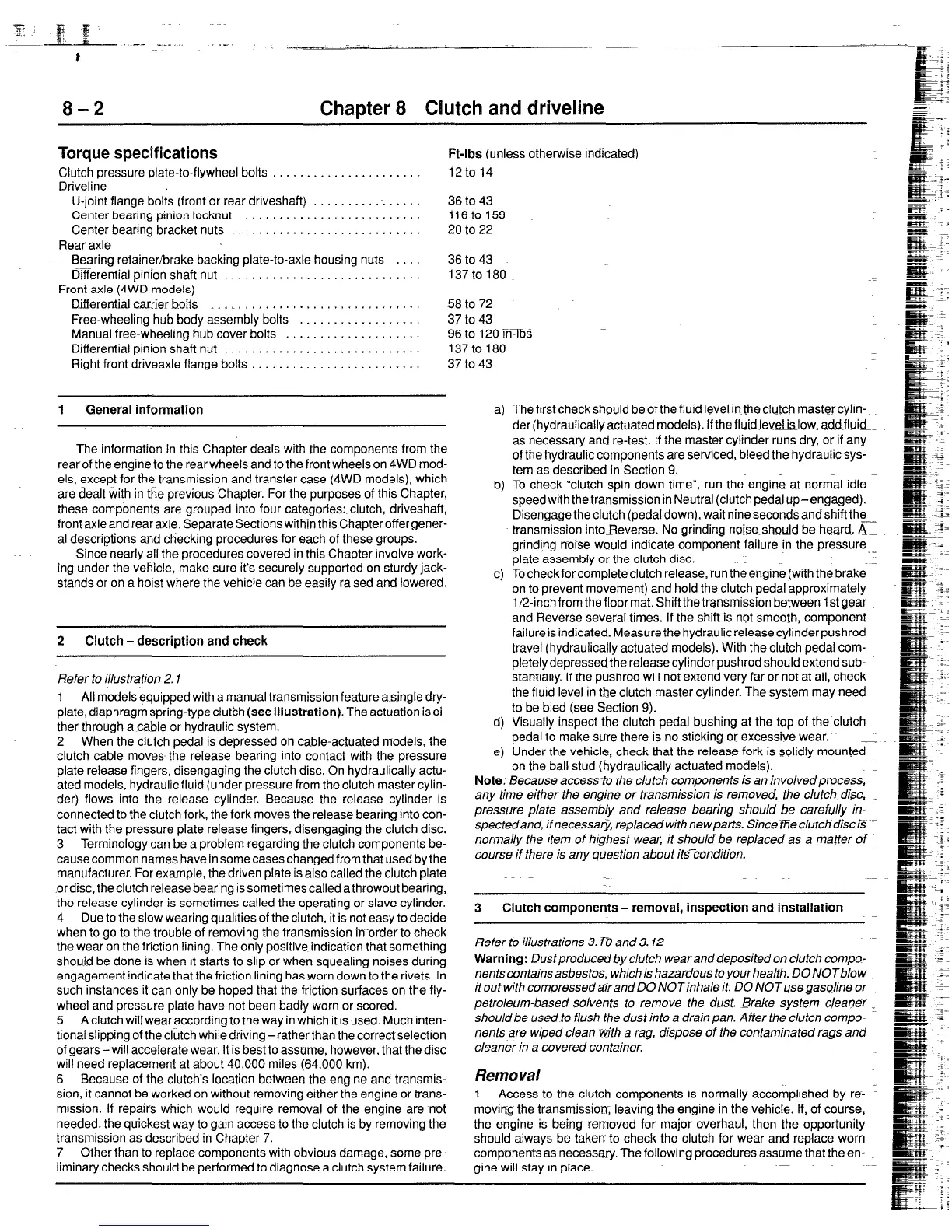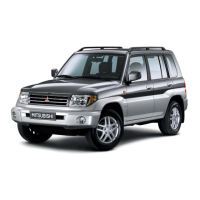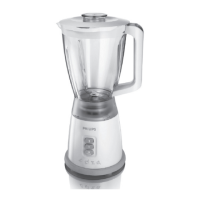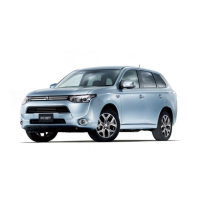8-2 Chapter 8 Clutch and driveline
Ft-lbs (unless otherwise indicated)
12to14
Torque specifications
Clutch pressure plate-to-flywheel bolts . . . . . . . . . . . .
Driveline
U-joint flange bolts (front or rear driveshaft) . . . :.
Center bearing pinion locknut . . I . . .
Center bearing bracket nuts . . . . . . . .
Rear axle
.
36 to 43
. . 116to 159
. . 20 to 22
Bearing retainer/brake backing plate-to-axle housing nuts 36 to 43
Differential pinion shaft nut . . I . . . . . . 137to 180
Front axle (4WD models)
Differential carrier bolts _ _ . _ . . . . . . .
Free-wheeling hub body assembly bolts . . . _ . . .
Manual free-wheeling hub cover bolts . . . . . . . . .
Differential pinion shaft nut . . . . . . . . 137to 180
Right front driveaxle flange bolts . . . _ . . . 37 to 43
. .
58 to 72
. 37 to 43
. 96 to 120 KIbs
1 General information
The information in this Chapter deals with the components from the
rearof the engine to the rear wheels and to the front wheels on 4WD mod-
els, except for the transmission and transfer case (4WD models), which
are dealt with in the previous Chapter. For the purposes of this Chapter,
these components are grouped into four categories: clutch, driveshaft,
front axle and rear axle. Separate Sections within this Chapter offergener-
al descriptions and checking procedures for each of these groups.
Since nearly all the procedures covered in this Chapter rnvolve work-
ing under the vehicle, make sure it’s securely supported on sturdy jack-
stands or on a hoist where the vehicle can be easily raised and lowered.
2 Clutch -description and check
Refer to illustration 2.1
1 All models equipped with a manual transmission feature asjngle dry-
plate, diaphragm spring-type clutch (see illustration). The actuation is ei-
ther through a cable or hydraulic system.
2 When the clutch pedal is depressed on cable-actuated models, the
clutch cable moves the release bearing into contact with the pressure
plate release fingers, disengaging the clutch disc. On hydraulically actu-
ated models, hydraulic fluid (under pressure from the clutch master cylin-
der) flows into the release cylinder. Because the release cylinder is
connected to the clutch fork, the fork moves the release bearing into con-
tact with the pressure plate release fingers, disengaging the clutch disc.
3 Terminology can be a problem regarding the clutch components be-
cause common names have in some cases changed from that used by the
manufacturer. For example, the driven plate is also called the clutch plate
or disc, the clutch release bearing is sometimes called a throwout bearing,
the release cylinder is sometimes called the operating or slave cylinder.
4 Due to the slow wearing qualities of the clutch, it is not easy to decide
when to go to the trouble of removing the transmission fnorderto check
the wear on the friction lining. The only positive indication that something
should be done is when it starts to slip or when squealing noises during
engagement indicate that the friction lining has worn down to the rivets. In
such instances it can only be hoped that the friction surfaces on the fly-
wheel and pressure plate have not been badly worn or scored.
5 A clutch wiliwear according to the way in which it is used. Much inten-
tional slipping of the clutch while driving-rather than the correctselection
of gears-will accelerate wear. It is best to assume, however, that the disc
will need replacement at about 40,000 miles (64,000 km).
6 Because of the clutch’s location between the engine and transmis-
sion, it cannot be worked on without removing either the engine or trans-
mission. If repairs which would require removal of the engine are n~ot
needed, the quickest way to gain access to the clutch is by removing the
transmission as described in Chapter 7.
7 Other than to replace components with obvious damage, some pre-
liminary checks should be performed to diagnose a clutch system failure.
4
4
4
4
The frrst check should be of the fluid level in the clutch master cylin-
der (hydraulically actuated models). If the fluid levelis low, add fluid-
as necessary and re-test. If the master cylinder runs dry, or if any
of the hydraulic components are serviced, bleed the hydraulic sys-
tem as described in Section 9.
To check “clutch spin down time”, run the engine at normal idle
speedwith the transmission in Neutral (clutch pedal up-engaged).
Disengage the clutch (pedal down), wait nine seconds and shift the
transmissron intoReverse. No grinding noise should be heard. A-
grinding noise would indicate component failure in the pressure._
plate assembly or the clutch disc.
To checkforcomplete clutch release, run theengine (with the brake
on to prevent movement) and hold the clutch pedal approximately
l/2-inch from the floor mat. Shiftthe transmission between lstgear
and Reverse several times. If the shift is not smooth, component
failure is indicated. Measure the hydraulic release cylinder pushrod
travel (hydraulically actuated models). With the clutch pedal com-
pietelydepressedthe release cylinder pushrod should extend sub-
stantrally. If the pushrod will not extend very far or not at ail, check
the fluid level in the clutch master cylinder. The system may need
to be bled (see Section 9).
Visually inspect the clutch pedal bushing at the top of the clutch
pedal to make sure there is no sticking or excessive wear.
Under the vehicle, check that the release fork is solidly mounted-
on the ball stud (hydraulically actuated models).
Note: Because accessto the clutch components is an involvedprocess,
any time either the engine or transmission is removed, the clutch disc, I
pressure plate assembly and release bearing should be carefully in-
spectedand, if necessar$ replaced with newparts. Since tTie clutch disc is ~~
normally the /tern of highest wear, it should be replaced as a matter of
courseif there is any question about its%ondition.
3 Clutch components - removal, inspection and installation
Refer to illustrations 3. TD and 3.12
Warning: Dustproducedby clutch wearanddeposited on clutch compo-
nentscontamsasbestos, whrchis hazardous toyourhealth. DO NOTbbw
itout with compressed airand DO NOTinhale it. DO NOTusegasoline or
petroleum-based solvents to remove the dust. Brake system cleaner .
should be used to flush the dust into a drain pan. After the clutch compo-
nents are wiped clean with a rag, dispose of the contaminated rags and
cleaner in a covered container.
-
Removal
1 Access to the clutch components is normally accomplished by re- ’
moving the transmission leavrng the engine in the vehicle. If, of course,
the engine is being removed for major overhaul, then the opportunity
should always be taken. to check the clutch for wear and replace worn
components as necessa.v. The following procedures assume that the en-
gine will stay In place.

